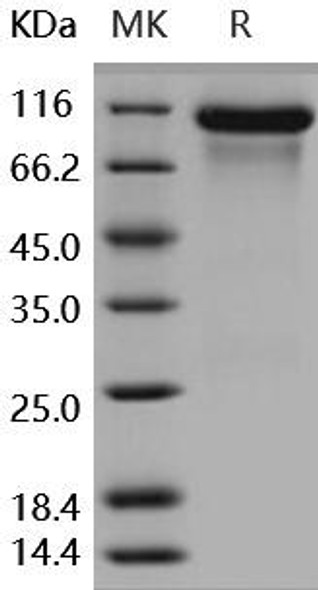Description
| Product Name: | Mouse ErbB3 Recombinant Protein |
| Product Code: | RPPB5833 |
| Size: | 10µg |
| Species: | Mouse |
| Target: | ErbB3 |
| Synonyms: | Receptortyrosine-protein kinase erbB-3, Glial growth factor receptor, Proto-oncogene-likeprotein c-ErbB-3. |
| Source: | Sf9 Insect cells |
| Physical Appearance: | Sterile Filtered colorless solution. |
| Formulation: | ErbB3 protein solution (0.5mg/ml) contains Phosphate Buffered Saline (pH 7.4) and 10% glycerol. |
| Stability: | Store at 4°C if entire vial will be used within 2-4 weeks.�Store, frozen at -20°C for longer periods of time.�For long term storage it is recommended to add a carrier protein (0.1% HSA or BSA).�Avoid multiple freeze-thaw cycles. |
| Purity: | Greater than 90.0% as determined by SDS-PAGE. |
| Amino Acid Sequence: | SEMGNSQAVC PGTLNGLSVT GDADNQYQTL YKLYEKCEVV MGNLEIVLTGHNADLSFLQW IREVTGYVLV AMNEFSVLPL PNLRVVRGTQ VYDGKFAIFV MLNYNTNSSH ALRQLRFTQLTEILLGGVYI EKNDKLCHMD TIDWRDIVRV PDAEIVVKNN GGNCPPCHEV CKGRCWGPGPEDCQILTKTI CAPQCNGRCF GPNPNQCCHD ECAGGCSGPQ DTDCFACRHFNDSGACVPRC PAPLVYNKLT FQLEPNPHIK YQYGGVCVAS CPHNFVVDQT FCVRACPADK MEVDKNGLKMCEPCRGLCPK ACEGTGSGSR YQTVDSSNID GFVNCTKILG NLDFLITGLN GDPWHKIPALDPEKLNVFRT VREITGYLNI QSWPPHMHNF SVFSNLTTIG GRSLYNRGFSLLIMKNLNVT SLGFRSLKEI SAGRVYISAN QQLCYHHSLN WTRLLRGPAE ERLDIKYNRP LGECVAEGKVCDPLCSSGGC WGPGPGQCLS CRNYSREGVC VTHCNVLQGE PREFVHEAHC FSCHPECQPMEGTSTCNGSG SDACARCAHFRDGPHCVNSC PHGILGAKGP IYKYPDAQNE CRPCHENCTQ GCKGPELQDC LGQAEVLMSK PHLEHHHHHH |
ErbB3, also called Her3 (human epidermal growth factor receptor 3), is a type I membrane glycoprotein that is a member of the ErbB family of tyrosine kinase receptors. ErbB family members serve as receptors for the epidermal growth factor (EGF) family of growth factors. Among ErbB family members, ErbB3 is unique in that it contains a defective kinase domain. ErbB3 is expressed in keratinocytes, melanocytes, skeletal muscle cells, embryonic myoblasts and Schwann cells. Monomeric ErbB3 serves as a low affinity receptor for the heregulins (HRG). ErbB3 can induce specific antibody production in vivo, hence to inhibit tumor cell growth. ErbB-3 can be used to treat early, medium and advanced or post-operative breast cancer with over-expression of ErbB2. According to its mechanism of action, ErbB3 is classified as a therapeutic for cancer.
ErbB3 produced in Sf9 Baculovirus cells is a single, glycosylated polypeptide chain containing 630 amino acids (20-641.a.) and having a molecular mass of 69.5kDa (Molecular size on SDS-PAGE will appear at approximately 70-100kDa).�ErbB3 is expressed with an 8 amino acid His tag at C-Terminus and purified by proprietary chromatographic techniques.
| UniProt Protein Function: | HER3: a receptor tyrosine kinase of the EGFR family. Binds and is activated by neuregulins and NTAK. Can form homodimers or ErbB-2/ErbB-3 heterodimers. Kinase domain lacks activity but heterodimerizes with other EGFRs to transduce growth signals. May be required for HER2 activity. Elevated expression in breast and other tumors is indicative of poor outcome. A secreted form is expressed in metastatic prostate cancer Two alternatively spliced isoforms have been described.Protein type: Oncoprotein; EC 2.7.10.1; Protein kinase, tyrosine (receptor); Membrane protein, integral; Kinase, protein; Protein kinase, TK; TK group; EGFR familyCellular Component: apical plasma membrane; basolateral plasma membrane; extracellular space; lateral plasma membrane; nucleus; postsynaptic membrane; receptor complexMolecular Function: growth factor binding; identical protein binding; protein binding; protein heterodimerization activity; protein tyrosine kinase activator activity; protein-tyrosine kinase activityBiological Process: cranial nerve development; epidermal growth factor receptor signaling pathway; negative regulation of cell adhesion; negative regulation of neuron apoptosis; negative regulation of secretion; negative regulation of signal transduction; neuron apoptosis; peripheral nervous system development; phosphoinositide 3-kinase cascade; positive regulation of cardiac muscle development; positive regulation of glucose import; regulation of cell proliferation; Schwann cell differentiation; signal transduction; transmembrane receptor protein tyrosine kinase signaling pathway |
| UniProt Protein Details: | |
| NCBI Summary: | |
| UniProt Code: | Q61526 |
| NCBI GenInfo Identifier: | 77416857 |
| NCBI Gene ID: | 13867 |
| NCBI Accession: | Q61526.2 |
| UniProt Secondary Accession: | Q61526,Q3KQR1, Q68J64, Q810U8, Q8K317 |
| UniProt Related Accession: | Q61526 |
| Molecular Weight: | 147,613 Da |
| NCBI Full Name: | Receptor tyrosine-protein kinase erbB-3 |
| NCBI Synonym Full Names: | erb-b2 receptor tyrosine kinase 3 |
| NCBI Official Symbol: | Erbb3�� |
| NCBI Official Synonym Symbols: | Her3; C76256; Erbb-3; Erbb3r�� |
| NCBI Protein Information: | receptor tyrosine-protein kinase erbB-3 |
| UniProt Protein Name: | Receptor tyrosine-protein kinase erbB-3 |
| UniProt Synonym Protein Names: | Glial growth factor receptor; Proto-oncogene-like protein c-ErbB-3 |
| Protein Family: | Receptor tyrosine-protein kinase |
| UniProt Gene Name: | Erbb3�� |
| UniProt Entry Name: | ERBB3_MOUSE |










